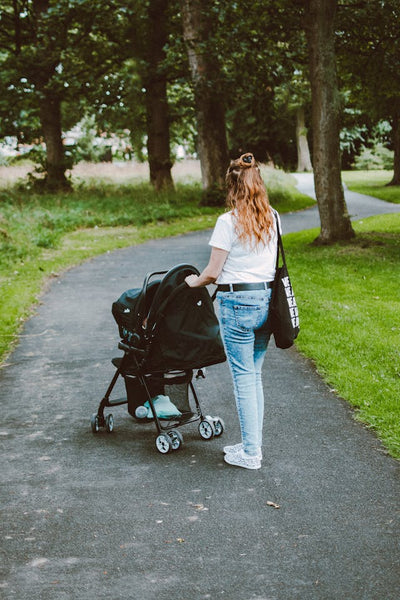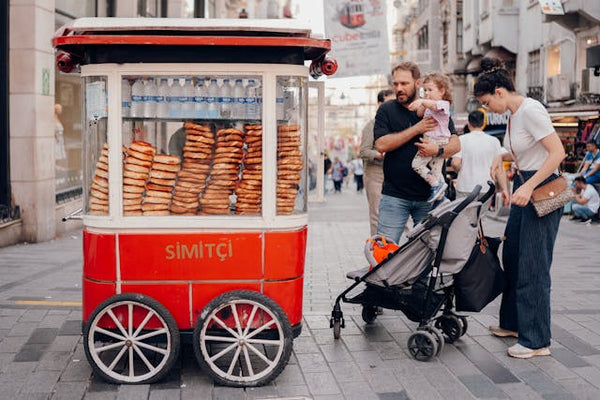Ultimate Guide to Choosing the Right Stroller for Your Baby

*Updated: 02 Dec 2024
ANB Baby knows that keeping your little one safe and comfortable on the go is a top priority for parents. Part of that means having a stroller that fits your lifestyle. With so many options available in the market, choosing the right stroller can be a daunting task for parents-to-be. That’s why ANB Baby has created a comprehensive guide that aims to simplify the process! Join us as we explore stroller buying basics, various types of strollers, essential features and accessories you’ll love, and practical tips on how to test-drive a stroller.
Stroller Buying Basics: Factors to Consider
Before we dive into the specifics of different stroller types, it's crucial to understand the basic factors that should guide your purchasing decision. These factors will not only impact your daily routine but also contribute to the overall safety and comfort of your little one.
Lifestyle and Usage Patterns: Choose a Stroller That Can Keep Up!
Understanding your lifestyle and usage patterns is a pivotal starting point in the quest for the perfect stroller. Consider the activities that define your daily routine and the places you envision taking your baby. If you're a family that loves the outdoors, exploring parks, and trails, or engaging in physical activities, a sturdier, all-terrain stroller might be the ideal fit. On the other hand, if your urban lifestyle involves frequent trips to crowded places or public transportation, a more compact and lightweight stroller could be a game-changer, ensuring maneuverability and ease of use in tight spaces.
You’ll also want to think about how frequently you'll be using the stroller. For parents who plan on incorporating the stroller into their daily routine for walks, errands, and other outings, durability and comfort become paramount. On the flip side, if you anticipate using the stroller occasionally or for specific events, a travel-friendly and easy-to-fold option might be more suitable. By choosing a stroller that fits with your lifestyle and how you plan to use it, you’ll not only have a better experience as a parent but also provide your baby with a comfortable and secure ride tailored to their needs.
Stroller Safety Features: Keep Your Little One Secure
All strollers sold in the United States must comply with the mandatory federal safety standard 16 CFR 1227, which incorporates the American Society for Testing and Materials (ASTM) F833 stroller safety standard. But to give yourself even more peace of mind, make sure the stroller you choose has a JPMA-Certified sticker. It means that the Juvenile Products Manufacturers Association has certified that the stroller meets the mandatory federal requirements, plus the JPMA’s additional requirements. You can also consult the stroller experts at ANB Baby for more info on how specific strollers perform.
Number of Children You Plan to Have: Choose a Stroller That Can Accommodate Them All
Consider the future size of your family when choosing a stroller. If you expect to have two children who will both need a stroller, a double stroller is a wise investment. Not sure yet? Some strollers start as a single standard but allow you to add a second seat when needed, transforming into a double stroller. This adaptable design (also known as a convertible stroller) not only accommodates your growing family but also saves you from the expense of purchasing a separate double stroller later on. You can easily revert to a single stroller configuration when your older child no longer requires a stroller, making it a versatile and cost-effective choice for evolving family dynamics.
Size and Weight: How Much Stroller Do You Need?
The dimensions of your chosen stroller play a crucial role in determining how seamlessly it integrates into your living space and accompanies you on your outings. In urban settings with limited storage space, a compact and foldable stroller can be a game-changer, easily fitting into closets, car trunks, or tight corners at home. On the other hand, if you have ample storage space and frequently venture on more extended outings, a larger stroller with added features may be a worthwhile investment.
The weight of the stroller is equally consequential. A lightweight stroller can be a relief for parents who are constantly on the move, making it easier to lift, carry, and maneuver. This is particularly advantageous when navigating stairs, public transportation, or crowded areas. Conversely, if your daily activities involve more relaxed strolls or you have the convenience of a car for transportation, a slightly heavier stroller might be acceptable, especially if it comes with additional features that contribute to your baby's comfort. Striking the right balance between size and weight ensures that your chosen stroller complements your lifestyle rather than becoming a cumbersome addition to it.
Ease of Folding and Maneuverability: Choose a Stroller That's Easy to Use
The convenience of folding and maneuvering your stroller is a daily necessity that can significantly impact your parenting experience. A stroller that offers easy folding and unfolding, preferably with just one hand, is a practical asset. Imagine holding your baby in one arm and effortlessly folding the stroller with the other when entering a busy café or navigating through a bustling market – it's these small conveniences that make a big difference.
Maneuverability is equally crucial, especially in dynamic urban environments. A stroller with smooth and responsive steering allows you to navigate tight corners, crowded streets, or busy shopping aisles without breaking a sweat. This feature becomes particularly important for parents who often find themselves in bustling urban spaces or public transportation. Whether it's making a quick turn to catch the elevator or effortlessly gliding through a crowded sidewalk, a maneuverable stroller makes these everyday scenarios much more manageable, allowing you to focus on the joy of strolling with your baby rather than wrestling with the equipment.

Characteristics of Different Stroller Types
Now that you've considered the basics, let's explore the characteristics of various stroller types, each designed to cater to specific needs.
Single Standard Strollers
Single standard strollers, the quintessential choice for many parents, come with a range of features catering to various needs. Some standout options, like convertible strollers, offer unparalleled versatility. Models such as the UPPAbaby VISTA V3 Stroller and the Nuna Demi Next Stroller are designed to adapt from a single stroller to a double seamlessly. This flexibility makes them ideal for growing families, providing the convenience of accommodating an additional child when needed. Convertible strollers often feature reversible seats, allowing your baby to face either you or the world, enhancing interaction and engagement.
Many single standard strollers go the extra mile by offering bassinet options. Strollers like the Cybex Gazelle S 2 provide a cozy and secure space for newborns, allowing them to lie flat and comfortably nap while on the go. This bassinet feature eliminates the need for a separate pram and ensures that your newborn travels in optimal comfort. Additionally, some single strollers, such as the Cybex e-Priam, incorporate technology into their design, featuring apps that provide insights into your strolling habits, track your routes, and even monitor your baby's well-being. While these tech-savvy additions might appeal to some, others may find them non-essential. Overall, single standard strollers offer a diverse range of features, providing options for every parent's preference and lifestyle.
Pros and Cons of Single Standard Strollers
Pros:
- Versatile, allowing for easy adaptation to changing family needs.
- Robust with ample storage space.
- Smooth ride for various terrains.
- Good for newborns.
- Technological features
Cons:
- Bulkier and heavier compared to more compact options.
- Less convenient for quick trips or travel.

Lightweight Strollers
Lightweight strollers are the standard for parents who prioritize ease of use and portability. Strollers like the Nuna TRVL lx Stroller and UPPAbaby MINU V2 Stroller are designed for effortless travel and quick outings. Weighing significantly less than their full-size counterparts, lightweight strollers are easy to lift, carry, and maneuver, making them ideal for parents who are frequently on the move. The compact fold of these strollers is a standout feature, allowing them to fit into tight spaces, including the trunk of smaller cars or even the overhead bin of an airplane. This travel-friendly aspect ensures that you can take your stroller with you wherever you go, whether it's a weekend getaway or a family vacation.
Pros and Cons of Lightweight Strollers
Pros:
- Compact and portable design, perfect for travel.
- Easy to lift and maneuver, especially in crowded spaces.
- Quick and simple folding mechanisms.
- Some models fit in the overhead bin of airplanes.
- Suitable for short outings and urban environments.
Cons:
- Limited storage space compared to full-size strollers.
- May lack some features present in larger strollers.
- Not as suitable for rough terrains or off-road use.
- Less stability compared to heavier strollers.
- May have a shorter lifespan as children grow.

Jogging Strollers
Pros and Cons of Jogging Strollers
Pros:
- Suitable for active parents who enjoy jogging or running.
- Large, air-filled tires provide a smooth ride on different terrains.
- Three-wheel design enhances stability and maneuverability.
- Locking front wheel for jogging, easily unlocked for regular strolling.
- Some models offer adjustable suspension for a comfortable ride.
Cons:
- Bulkier and heavier than standard strollers.
- Not as compact or easy to fold for travel or storage.
- May lack certain features found in everyday strollers.
- Limited use for non-active outings or crowded spaces.
- Typically more expensive than other stroller types.

Double Strollers
Double strollers, designed to accommodate two children simultaneously, offer a versatile solution for parents of twins or siblings close in age. There are various types of double strollers catering to different preferences and lifestyles. City dweller strollers like the UPPAbaby G-Link V2 Double Stroller focus on narrow designs to navigate crowded urban spaces, while all-terrain models such as the Bumbleride Indie Twin Double Jogging Stroller provide durability and stability for outdoor adventures. Side-by-side double strollers like the Nuna TRVL Dubl provide a comfortable view for both children and often come with adjustable canopies. Though double strollers offer significant advantages fro some families, their bulkier and heavier nature requires careful consideration of your lifestyle and the spaces you frequently navigate. As with any stroller choice, finding the right fit involves weighing the pros and cons against your specific needs and anticipated usage patterns.
Pros and Cons of Double Strollers
Pros:
- Ideal for parents of twins or children close in age.
- Various types cater to different preferences (city dweller, all-terrain, side-by-side, in-line).
- Allows for a single stroller solution for multiple children.
- Some models come with high-performance features.
- Offers versatility for growing families.
Cons:
- Can be wider and more challenging to navigate through crowded spaces.
- Generally heavier and bulkier than single strollers.
- Not as compact or easy to fold for travel or storage.
- High-performance features may come with a higher price tag.

Travel Systems
Travel systems are a comprehensive solution for parents seeking seamless integration between car travel and strolling. These systems typically include a stroller, a compatible car seat, and sometimes additional accessories. The convenience of a stroller with a car seat attachment allows for a smooth transition between the car and strolling without disturbing your sleeping baby. Models like the Nuna MIXX Next Stroller offer this adaptability, ensuring that your little one stays comfortable and undisturbed during the transfer.
Moreover, travel systems often provide versatility beyond infancy. Some models come with bassinet attachments for newborns, giving them a flat and secure space for napping while on the go. The all-terrain capability of certain travel systems, such as the Cybex EOS Travel System with Aton G Infant Car Seat, makes them suitable for various terrains, enhancing their usability. Additionally, convertible travel systems offer the flexibility to adapt as your child grows, with options to switch between a stroller and a toddler seat.
Pros and Cons of Travel Systems
Pros:
- Seamless transition from car to stroller with car seat attachments.
- Some models come with bassinet attachments for newborns.
- Versatile options, including all-terrain travel systems.
- Convenient for on-the-go parents who want an all-in-one solution.
- Convertible travel systems adapt to the needs of growing children.
Cons:
- Travel systems can be bulkier and heavier than standalone strollers.
- May have a higher price point due to additional features.
- Some models might lack the lightweight design of dedicated strollers.
- Limited customization compared to individual stroller and car seat choices.
- Not as compact for travel or storage as lightweight strollers.

Features and Accessories to Look for in a Stroller
Choosing the right type is only part of the equation. The features and accessories your stroller offers can significantly enhance your overall experience. Here are a few key features and accessories to look for when selecting the perfect stroller:
- Five-Point Harness: Opt for strollers with a five-point harness for maximum safety. This system uses straps over the shoulders, hips, and between the legs to secure your child in the stroller and keep them from climbing out or sliding or falling. Check to make sure the buckles are simple for adults to operate but hard for little ones to unfasten. The straps should be easily adjustable for proper fit and be securely anchored.
- Brake System: Check the brake system to be sure it’s reliable and easy to engage. Many strollers are foot-activated, providing convenience for parents. Some of these are one-touch or linked brakes that you activate with a tap of your foot on a bar at the back of the stroller frame. Others have a brake pedal above each rear wheel. Some strollers feature a hand-operated lever that triggers both rear-wheel brakes.
- Adjustable Canopy: Protect your baby from the sun and wind with a stroller that has an adjustable canopy. Look for UV protection features to shield your little one from harmful rays.
- Reclining Seat: Ensure your stroller has a seat that can recline to different positions. For newborns who can't sit up on their own, a fully reclined position provides a comfortable and safe space.
- Ample Storage: Consider the storage space available in the stroller. A good-sized basket underneath or additional compartments give you more room for baby essentials, your belongings, and even shopping bags.
- Adjustable Handlebar: An adjustable handlebar accommodates parents of different heights, allowing you to have a comfortable pushing experience. This feature is particularly beneficial when more than one parent will be using the stroller.
- Convertible Options: Consider strollers that offer convertible features, such as the ability to transform from a single stroller to a double or convert between a bassinet and a regular seat. This adaptability allows the stroller to grow with your family's changing needs.
- Tech-Savvy Additions: Some modern strollers come with tech features, such as apps that track your strolling habits, monitor your baby's well-being, or provide insights into your routes. While these may not be essential, they can add a touch of convenience and modernity to your parenting experience.
- Easy Folding Mechanism: Look for strollers with a simple and quick folding mechanism. Strollers that can be folded with one hand or feature a compact fold are especially valuable for parents on the go.
- Travel System Compatibility: If you plan to use a car seat with your stroller, check for compatibility with popular car seat models. Travel system options provide seamless transitions between car travel and strolling.

Savvy Tips on How to Test Drive a Stroller
Before finalizing your decision, it's crucial to test-drive the stroller to ensure it meets your expectations. Here's a step-by-step guide on how to do it:
- Fold and unfold. Practice folding and unfolding the stroller. Make sure you can do it easily and preferably with just one hand. Is it manageable and easy to lift? Consider bringing a tape measure to double-check the dimensions. Evaluate whether the stroller will fit easily into the trunk of your car or in your building’s stairwells.
- Take the stroller for a spin. Test how easily it maneuvers through different surfaces and tight spaces. Add weight, like a heavy purse, to the stroller seat, then push it around the store. Is it smooth and easy to operate?
- Test the brake system. Is it responsive and easy to use? Make sure it engages smoothly and holds the stroller securely in place.
- Experiment with the adjustable features. Recline the seat. Pull the canopy down and back. Adjust the handlebar. Detach and reattach the car seat. Are these features smooth and intuitive to operate?
- Evaluate the storage space. Examine the basket, zippered pockets, consoles, and any other storage the stroller might have. Check if they’re sufficient for your needs and if accessing items is convenient.

The Bottom Line on Choosing the Right Stroller for Your Baby
Choosing the right stroller is a crucial decision for parents, impacting daily routines, comfort, and safety. Understanding your lifestyle and exploring the characteristics of various stroller types can help you make an informed decision. Pay attention to special features and accessories, and don’t forget to conduct a thorough test drive to make sure that the stroller you’re considering aligns perfectly with your family's needs. As you begin this exciting chapter of parenthood, may your choice of stroller be a reliable companion in every adventure with your little one!









